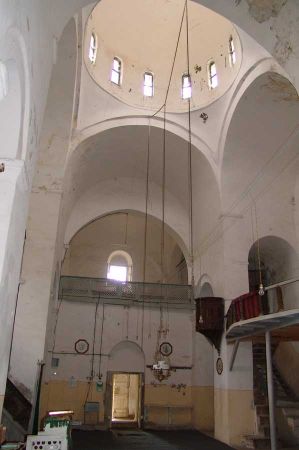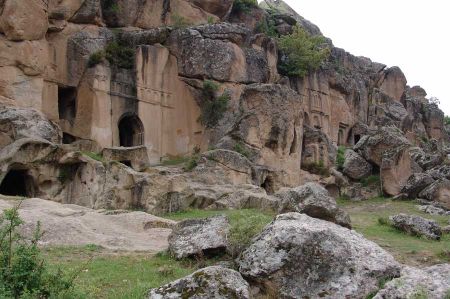During our tour through southwestern Cappadocia, we came to Güzelyurt, a small town of approx. 3,100 inhabitants, which is about 32 kilometers east of the provincial capital Aksaray.
Quite sleepy, the first impression we got when we drove into town. Very quiet, just little traffic and only a few passers-by are on the street on this rather dull day. We drove to the center of the village, parked the vehicle and started the exploration tour on foot.
 Some church buildings immediately catch the eye, suggesting the former Christian settlement of the place. If you do some research in history, you will quickly come across the former name of the city "Karballa". Around the 3rd century AD, various Christian monastery communities settled in the region, which are also responsible for founding the Karballa settlement. Only a few years later, Bishop Gregory of Nazians, known as the “Cappadocian Church Father”, moved to Karballa. In addition to Gregory, this title was only awarded to Bishop Basil the Great and his brother Gregory of Nyssa. Together these three shaped the theology of the 4th century and worked out the doctrine of the Trinity (the essential unity of God the Father, Son (Jesus Christ) and Holy Spirit).
Some church buildings immediately catch the eye, suggesting the former Christian settlement of the place. If you do some research in history, you will quickly come across the former name of the city "Karballa". Around the 3rd century AD, various Christian monastery communities settled in the region, which are also responsible for founding the Karballa settlement. Only a few years later, Bishop Gregory of Nazians, known as the “Cappadocian Church Father”, moved to Karballa. In addition to Gregory, this title was only awarded to Bishop Basil the Great and his brother Gregory of Nyssa. Together these three shaped the theology of the 4th century and worked out the doctrine of the Trinity (the essential unity of God the Father, Son (Jesus Christ) and Holy Spirit).
Gregor von Nasianz was born around 329 in Arianzoz, a little east of Aksaray. Gregory is one of the three great Greek Doctors of the Church of the so-called "Old Church", who was officially allowed to bear the title of "Theologian".
Gregor von Nasianz - the first official theologian
 The other two theologians are the apostles John and Symeon, the so-called "New Theologian". Even today the Orthodox Church celebrates the "Feast of the Three Holy Hierarchs" on January 30th, a day that is seen in Greek Orthodox Christianity as the day of the patron saints of education. So this day is a school and university holiday. The group of the “Three Holy Hierarchs” includes Bishop Basil the Great and Bishop John Chrysostom as well as Bishop Gregory of Nazianzen. As a bishop he mainly worked in Sasima, which is still called the titular diocese of Sasima and is now called Çavdarlı. Gregor von Nazianz died on January 25, 390 in Arianzos.
The other two theologians are the apostles John and Symeon, the so-called "New Theologian". Even today the Orthodox Church celebrates the "Feast of the Three Holy Hierarchs" on January 30th, a day that is seen in Greek Orthodox Christianity as the day of the patron saints of education. So this day is a school and university holiday. The group of the “Three Holy Hierarchs” includes Bishop Basil the Great and Bishop John Chrysostom as well as Bishop Gregory of Nazianzen. As a bishop he mainly worked in Sasima, which is still called the titular diocese of Sasima and is now called Çavdarlı. Gregor von Nazianz died on January 25, 390 in Arianzos.
Over the following centuries Güzelyurt, which was renamed Gelveri after Karballa, was settled by Greeks who were famous for their goldsmithing and pottery design. More than 100 churches were built during this time. With the so-called population exchange between Greece and Turkey in 1923, the Greeks were replenished by Turkish new settlers from the Greek Kostoria and the Turkish Kozan. Gelveri has now become the new name Güzelyurt, meaning “beautiful home”.
Yüksek Kilise - worth seeing it
Just outside the town there are a large number of Christian cave churches and monastery complexes, which are carved into the relatively soft tuff rock of the so-called Güzelyurt Monastery Valley (Manastır Vadısı). It is only about 6 kilometers from here to the Ihlara valley to the south-west with numerous other rock-hewn churches. There are also two underground cities just outside Güzelyurt. Another underground city complex, which is now used as a disco, is located directly on the city's market square.
Also worth seeing is Yüksek Kilise, west of the reservoir, from the 19th century, which is located on a ridge, similar to a fortress. Unfortunately, the frescoes contained therein have been completely painted over. The Kızıl Kilise (Red Church), which was built between the 5th and 7th centuries AD, is much older but also a little higher in the landscape. It has striking reddish masonry, the origin of which is still unknown today. Unfortunately, the frescoes have also been completely destroyed here.
Please read as well:
Kızılırmak - longest river in Turkey and wetland at mouth!
A detour with consequences - Passage of the Lake Dojran


